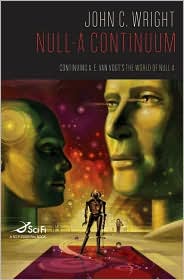
On jury duty last week, I didn't manage to get out a blog post—not an excuse, but I hope at least for my readers' sympathetic understanding. It took four days with a lot of waiting to finally find out that I wasn't going to get picked to serve as a juror in a murder trial. The jury selection process fascinated me nonetheless and I actually felt a little disappointed when the D.A. knocked me off of the panel. Beside that, the waiting time gave me a chance to catch up on my reading. One of the books I finished was John C. Wright's Null-A Continuum.
I met John C. Wright last month at the 2008 Alfred Korzybski Memorial Lecture weekend in New York City sponsored by the Institute of General Semantics. He drove up from Virginia, to speak on the last day of the conference about his book, based on the 'Null-A' world created by A.E. Van Vogt. Having read all three of Van Vogt's Null-A books years ago, I bought a copy of Wright's book, made sure that Wright signed it, and had a few pleasant minutes of conversation with him. I was amused when his young son, about 8 or 9 I guess, tried to get his father's attention while we were talking and Wright asked him to stop and take a "cortico-thalamic pause." More children should know how to do that!
The Null-A books, started as a series in Astounding science fiction magazine in the mid-1940s. Van Vogt's book The World of Null-A based on these stories came out in the late 1940s. It has continued to be in print in numerous editions (along with two sequels) since then. I read the Null-A books sometime in the 1960s or early 1970s. I was already a student of Korzybski's work and the books, with their 'weird' story of Gilbert Gosseyn, the Games Machine, the Semantic Institute on Korzybski Square, and a libertarian 'Null-A' society on Venus, had a compelling quality although I found the plot confusing. (Korzybski did too. He read the Astounding stories and when the book came out read that as well, three times in fact and still confessed confusion about what it was about. Korzybski wasn't actually very much of a science fiction reader.) The books stimulated a significant number of readers to learn more when they realized that Van Vogt based the non-aristotelian teachings of the book and the sayings that began each chapter on the work of an actual person named Korzybski. Though the books were my introduction to Van Vogt's writing, they are not my favorites among Van Vogt's writings. (I have since come to love much more The Voyage of the Space Beagle and some of his short stories (see The Best of A.E. Van Vogt).
The Null-A books were definitely a major influence and favorite of Wright, who as a young science fiction fan in the 1970s 'ate up' the stories which deeply resonated with something in him and provided a major inspiration for his eventual career as a science fiction writer. He got the permission of Van Vogt's widow to write a continuation of the series. And remarkably, he has managed somehow to capture Van Vogt's 'spirit' and voice in this book. For me, the book dragged a little toward the middle, which may have had something to do with the convoluted (to me) Van Vogt plot-line that Wright sought to continue. But Wright is a talented enough writer to have succeeded in grabbing my attention when I felt my interest lag (much as Van Vogt had the power to do) and I enjoyed the book. If you liked the Null-A books I think you will like this one, indeed you MUST get it since it gives a satisfying ending to the saga of Gilbert Gosseyn—one that Van Vogt could be proud of.
Interestingly, other than whatever he got from Van Vogt's books, Wright hasn't read Korzybski's work or any other G.S. literature (as far as I know). But he definitely has a feel for it, beginning each chapter with one of a number of apt 'Null-A' mottos that he has formulated, e.g., "The Laws of Men will never be just until they are sane," "Fear is the reaction of the living organism, not to threat, but to the perception of threat," "Analyzing the universe into simple binary opposites, while necessary, has limited value," et cetera. Null-A Continuum may even get some of its readers to seek to find out more about Korzybski and general semantics, just like Van Vogt's novels did.
Thumbs up to John C. Wright!
Links
Wikipedia biography of John C. Wright (caveat lector!)
John C. Wright's Web Log
Null-A Continuum on Amazon.com
A comprehensive website on A.E. Van Vogt and his Work
1 comment:
It was great to have John C. Wright participate in our symposium, to meet him and hear what he had to say, not to mention the fact that he cut a dashing figure!
Post a Comment